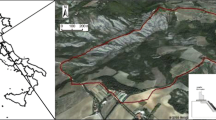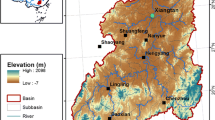Abstract
Despite continued interest in stream water temperature (Tw) analysis, there are few studies of Tw response to rainfall events at forested watersheds. We examined 61 sets of data on Tw for 21 rainfall events at 16 watersheds with various slope gradients (from 0.08 to 0.56) in four regions of Japan from June 2004 to December 2005. The investigation focused on the changes of specific discharge (ΔQs) and ΔTw at medium-sized watersheds (0.5–100 ha). The results clearly demonstrated different flow patterns expressed by Qs vs. Tw hysteretic loops. Those were clockwise in Period I (April–September) and counterclockwise in Period II (October–March), except for lower slope gradient at Aichi, where counterclockwise loops were observed in both periods. These differences in hysteretic loops could be explained by the differences in Tw and in response times to rainfall between surface/subsurface and groundwater flows. The response times were probably determined by the slope gradient and the vertical level of groundwater. We also found that the changes in air temperature (ΔTa) influenced ΔTw to a lesser degree than Qs. The average rainfall intensities in Period I and Period II (9.3 ± 1.7 and 5.4 ± 0.2 mm/h, respectively) affected the average values of ΔQs and ΔTw (6.62 ± 4.08 mm/h and 1.7 ± 0.4°C; 0.85 ± 0.68 mm/h and 0.9 ± 0.3°C, respectively). This indicates that slope gradient and Qs influenced ΔTw by changing the relative proportions of flow paths. In addition, the water table changes influenced the percentage of groundwater flow to the stream.





Similar content being viewed by others
References
Becker MW, Georgian T, Ambrose H, Siniscalchi J, Fredrick K (2004) Estimating flow and flux of groundwater discharge using water temperature and velocity. J Hydrol 296:221–233
Bogan T, Stefan HG, Mohseni O (2004) Imprints of secondary heat sources on the stream temperature/equilibrium temperature relationship. Water Resour Res 40:1–16
Bras RL (1990) Hydrology, an introduction to hydrologic science, chap 7. Groundwater flow in saturated porous media. Addison-Wesley, US, pp 283–312
Brown LE, Hannah DM (2007) Alpine stream temperature response to storm events. J Hydrometeorol 8:952–967
Brown LE, Hannah DM, Milner AM (2006) Hydroclimatological influences on water column and streambed thermal dynamics in an alpine river system. J Hydrol 325:1–20
Brutsaert W (2006) Hydrology, an introduction. Cambridge University Press, UK, p 605
Caissie D (2006) The thermal regime of rivers: a review. Freshw Biol 51:1389–1406
Dunham J, Schroeter R, Rieman B (2003) Influence of maximum water temperature on occurrence of Lahontan cutthroat trout within streams. North Am J Fish Manag 23:1042–1049
Eaton GJ, Scheller RM (1996) Effects of climate warming on fish thermal habitat in stream of the United States. Limnol Oceanogr 41:1109–1115
Edinger JR, Duttweiler DW, Geyer JC (1968) The response of water temperature to meteorological conditions. Water Resour Res 4:1137–1143
Fukushima T, Ozaki N, Kaminishi H, Harasawa H, Matsushige K (2000) Forecasting the changes in lake water quality in response to climate changes, using past relationships between meteorological conditions and water quality. Hydrol Process 14:593–604
Gu RR, Li Y (2002) River temperature sensitivity to hydraulic and meteorological parameters. J Environ Manag 66:43–56
Hannah DM, Malcolm IA, Soulsby C, Youngson AF (2004) Heat exchanges and temperatures within a salmon spawning stream in the Cairngorms, Scotland: seasonal and sub-seasonal dynamics. River Res Appl 20:635–652
Hawkins CP, Hogue JN, Decker LM, Feminella JW (1997) Channel morphology, water temperature, and assemblage structure of stream insects. J North Am Benthol Soc 16:728–749
Herb WR, Janke B, Mohseni O, Stefan HG (2008) Ground surface temperature simulation for different land covers. J Hydrol 356:327–343
Herschy RW (1985) Stream measurements, stream flow measurements. Elsevier, London
Huang M, Liang X, Leung LR (2008) A generalized subsurface flow parameterization considering subgrid spatial variability of recharge and topography. J Hydrometeorol 9:1151–1171
Jensen AJ, Johnsen BO, Saksgard L (1989) Temperature requirements in Atlantic salmon (Salmo salar), brown trout (Salmo trutta), and Arctic char (Salvelinus alpinus) from hatching to initial feeding compared with geographic-distribution. Can J Fish Aquat Sci 46:786–789
Kobayashi D (1985) Separation of the snowmelt hydrograph by stream temperatures. J Hydrol 76:155–162
Kobayashi D, Ishii Y, Kodama Y (1999) Stream temperature, specific conductance and runoff process in mountain watersheds. Hydrol Process 13:865–876
Lambs L (2004) Interactions between groundwater and surface water at river banks and the confluence of rivers. J Hydrol 288:312–326
Meyer JL, Sale MJ, Mulholland PJ, Poff NL (1999) Impacts of climate change on aquatic ecosystem functioning and health. J Am Water Resour Assoc 35:1373–1386
Mohseni O, Stefan HG (1999) Stream temperature/air temperature relationship: a physical interpretation. J Hydrol 218:128–141
O’Driscoll MA, DeWalle DR (2006) Stream-air temperature relations to classify stream-ground water interactions in a karst setting, central Pennsylvania, USA. J Hydrol 329:140–153
Onda Y, Yukawa N (1994) The influence of understories and litter layer on the infiltration of forested hillslopes. In: Proceeding of the international symposium on forest hydrology, Tokyo, Japan, Oct 1994, pp 107–114
Ozaki N, Fukushima T, Harasawa H, Kojiri T, Kawashima K, Ono M (2003) Statistical analyses on the effects of air temperature fluctuations on river water qualities. Hydrol Process 17:2837–2853
Resh VH, Brown AV, Covich AP, Gurtz ME, Li HW, Minshall GW, Riece SR, Sheldon AL, Wallace JB, Wissmar RC (1988) The role of disturbance in stream ecology. J North Am Benthol Soc 7:433–455
Shanley JB, Peters NE (1988) Preliminary observations of streamflow generation during storms in a forested Piedmont watershed using temperature as a tracer. J Contam Hydrol 3:349–365
Sinokrot BA, Gulliver JS (2000) In-stream flow impact on river water temperatures. J Hydraul Res 38:339–349
Sophocleous M (2002) Interactions between groundwater and surface water: the state of the science. Hydrogeol J 10:52–67
Subehi L, Fukushima T, Onda Y, Mizugaki S, Gomi T, Terajima T, Kosugi K, Hiramatsu S, Kitahara H, Kuraji K, Ozaki N (2009) Influences of forested watershed conditions on fluctuations in stream water temperature with special reference to watershed area and forest type. Limnology 10:33–45
Sugita M (1983) Changes in river water temperature with rainfall. Geogr Rev Jpn 56(12):835–843
Tanco R, Kruse E (2001) Prediction of seasonal water table fluctuations in La Pampa and Buenos Aires, Argentina. Hydrogeol J 9:339–347
Tani M (1997) Runoff generation processes estimated from hydrological observations on a steep forested hillslope with a thin soil layer. J Hydrol 200:84–109
Todd DK, Mays LW (2005) Groundwater hydrology, chap 7. Quality of groundwater. Wiley, US, pp 329–357
Tung CP, Lee TY, Yang YC (2006) Modelling climate-change impacts on stream temperature of Formosan landlocked salmon habitat. Hydrol Process 20:1629–1649
Uchida T, Asano Y, Onda Y, Miyata S (2005) Are headwaters just the sum of hillslopes? Hydrol Process 19:3251–3261
Vannote RL, Sweeney BW (1980) Geographic analysis of thermal equilibria: a conceptual model for evaluating the effect of natural and modified thermal regimes on aquatic insect communities. Am Nat 115:667–695
Ward JV (1985) Thermal characteristics of running waters. Hydrobiologia 125:31–46
Ward RC, Robinson M (2000) Principles of hydrology. McGraw-Hill, UK, p 450
Webb BW, Clack PD, Walling DE (2003) Water–air temperature relationships in a Devon river system and the role of flow. Hydrol Process 17:3069–3083
Webb BW, Hannah DM, Moore RD, Brown LE, Nobilis F (2008) Recent advances in stream and river temperature research. Hydrol Process 22:902–918
Westhoff MC, Savenije HHG, Luxemburg WMJ, Stelling GS, van de Giesen NC, Selker JS, Pfister L, Uhlenbrook S (2007) A distributed stream temperature model using high resolution temperature observations. Hydrol Earth Syst Sci 11:1469–1480
Acknowledgments
This research was supported by Japan Science and Technology Agency, Core Research for Evolutional Science and Technology. We express our thanks to all members involved in this project.
Author information
Authors and Affiliations
Corresponding author
Rights and permissions
About this article
Cite this article
Subehi, L., Fukushima, T., Onda, Y. et al. Analysis of stream water temperature changes during rainfall events in forested watersheds. Limnology 11, 115–124 (2010). https://doi.org/10.1007/s10201-009-0296-2
Received:
Accepted:
Published:
Issue Date:
DOI: https://doi.org/10.1007/s10201-009-0296-2




